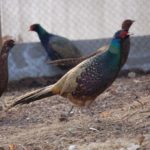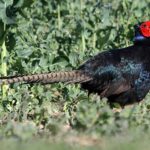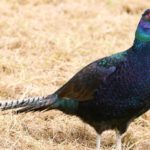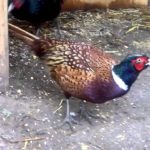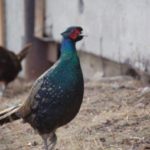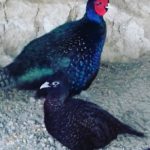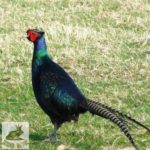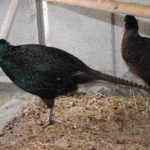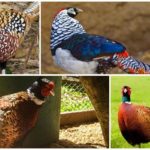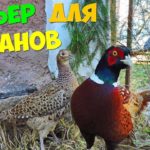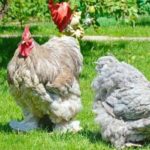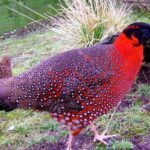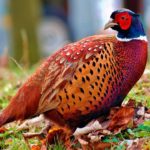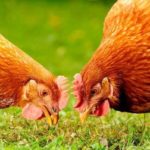The pheasant family includes many species, which differ in external characteristics and productivity. Let's consider the description of the Romanian pheasant, the main pros and cons of the breed. What rules exist for keeping birds in the household, how to properly create a diet. What to pay attention to when organizing pheasant breeding and how to prevent diseases.
Description and characteristics of the Romanian pheasant
The Romanian pheasant was bred from 2 subspecies - common and Japanese.The name “Romanian” is usually used in Russia; in European countries the name “emerald” or “green” is used. It was chosen because the males have dark green body plumage with a blue tint. They have a crest on their head. Females are gray-brown or brown.
The breed belongs to the meat category. Males can accumulate a mass of 2.5 kg, females - 2 kg. By 1.5 months, commercially raised pheasants can weigh 1 kg. The egg production of female Romanian pheasants is at the level of 20-60 eggs and depends on the age of the bird. Females lay eggs in April-May. Incubation lasts 3-4 weeks.
Advantages and disadvantages of the breed
However, despite its shortcomings, the Romanian breed is popular among poultry farmers.
Features of keeping and caring for birds
Pheasants are resistant to cold and can be kept in almost all Russian regions. In summer, they can spend all their time in covered pens in the fresh air. The aviary must be closed at the top to prevent birds from flying away.
The poultry house in which to keep pheasants in winter is built spacious and insulated. Windows are made in the walls for natural light and ventilation is installed. The floor is covered with a layer of straw or sawdust. The litter in which droppings accumulate is removed as it becomes dirty. While the birds are walking in the pen, the room is ventilated. Feeders and drinkers are installed on the floor.
Their number and volume should be such that all birds can approach the food at the same time, and there is enough space for everyone.
As soon as the pheasants have eaten, the remaining food must be removed. Water bowls should always be filled with water.In addition to feeders and drinkers, pheasants should have a container with ash and another with gravel, which they consume in order to digest food.
In the poultry house, pheasants of the Romanian breed must be kept separately from other types of birds. Some males are pugnacious and may attack neighbors. The area of the poultry house must be calculated so that each bird has at least 0.5 square meters. m., the area of the enclosure should be 2 times larger.
Diet planning
The basis of nutrition for Romanian pheasants is grain of various types. Birds can consume whole and chalked grains of wheat, corn, millet, barley and other grains. Legumes and their tops are also useful for them. They will not give up vegetables and root vegetables, tubers, fruits, berries.
After hatching from the egg, small pheasants are fed 5-6 times a day. They give you a mash of boiled eggs, greens cut into small pieces and non-sour cottage cheese. This mixture is fed for 3-4 days. Then millet, crushed wheat, and barley are gradually added to the feed. The proportion of grain is increased gradually, and the proportion of eggs and cottage cheese is reduced.
When the stomachs of the chicks become accustomed to solid food, they are given only grains and greens. Cake, bran, pulp are added to the mash. Separate rearing of pheasant chicks continues for a month, then they are transferred to the main stock in the poultry house.
Subtleties of pheasant breeding
Romanian pheasants lay eggs seasonally and rarely incubate eggs themselves. To guarantee the production of pheasant chicks at home, chicken incubators are used.Females begin to lay eggs at 6 months, but material for incubation must be collected from females 1-2 years old.
Eggs laid within 3 days are suitable for incubation, maximum within 2 weeks. Before storing, the material should be stored in a ventilated, dark, moderately warm room. Term incubation in Romanian pheasants – 24-25 days. Temperature conditions – 37.8-37.5 °C, humidity – 60-65%, in the last 2 days – 75-80%. Every day you need to turn the eggs and cool them for 10-15 minutes. To avoid manual turning, it is better to purchase an incubator with an automatic turning function.
Diseases of the breed
Pheasants can suffer from infectious diseases; they often appear in farms where the rules of care and hygiene are not followed or the birds are kept in crowded conditions. Infections can greatly thin out the livestock; in order to protect the farm from diseases, birds are vaccinated and given an antibiotic solution to drink. Individuals with signs of disease are immediately removed and treatment begins.
Among non-infectious diseases, metabolic diseases and hypovitaminosis, eating disorders are more common. Their causes are incorrect, unbalanced feeding, absence or lack of physical activity. When feeding wet mash with a liquid consistency, birds experience blockage of the crop. It is necessary to monitor the composition of the feed and the presence of water in the drinking bowls.
Romanian pheasants are a breed that is bred for meat, eggs and simply for decoration (due to their beautiful green plumage). Raising them is no more difficult than raising chickens. They live in an ordinary poultry house, but the walking pen must be covered, since the birds have not lost the desire to fly.

